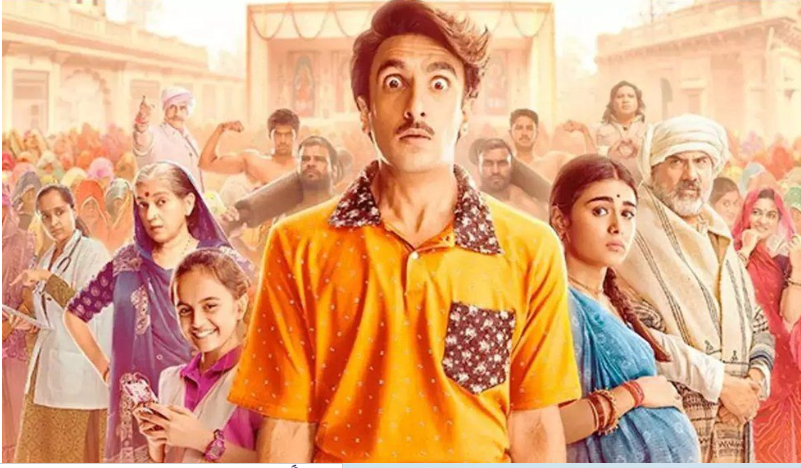Bollywood, the world’s biggest film industry by the number of movies produced globally every year, is struggling to make a comeback following two washout years of the pandemic.
Expectations that pent-up demand from movie-hungry audiences would lead to packed cinema halls have been belied by millions of dollars in lost revenue, as moviegoers become more discerning about where they spend their money.
Of the 20 odd notable Hindi films released in the first half of 2022, 15 have tanked at the box office, trade figures show.
These include projects helmed by some of the country’s biggest superstars; Ranveer Singh’s 83 and Jayeshbhai Jordaar, Akshay Kumar’s Samrat Prithviraj and Bachchhan Paandey and Kangana Ranaut’s Dhaakad.
“About $90m – $100m (£75.82m – £84.24m) has been lost between these films,” says trade expert Joginder Tuteja. “The recovery would have been all the more difficult if not for satellite and digital rights.”
Given this setback, overall theatrical revenues this year will not exceed $450m at best, reckons Mr Tuteja. That is a $100m short of the approximately $550m Hindi films made at the box office in 2019.
What ails the box office?
Weak content could be one of the reasons for this poor performance.
“Historically, Bollywood films have seen decent collections even when the content was weak, given the strong fan following of superstars. That seems to have changed with time, with content now being the primary driver,” a report by Emkay Global Financial Services said.
But what’s confounding producers is that mid-budget, content-heavy films that were the flavour of the box office pre-Covid haven’t done great business either.
“Audiences are now demanding both – great content and big scale,” says Bhushan Kumar, who runs one of the country’s leading movie studios T-Series, in the financial capital Mumbai.
Bhool Bhulaiyaa 2, a horror comedy produced by Mr Kumar’s T Series, has been one of the biggest grossers of 2022. Still, he admits there’s “great confusion” among producers about what will and will not work, following the recent spate of failures.
As makers like him grapple with changing audience tastes, and the fragmentation of viewership between theatres and streaming platforms, greenlighting a film has become trickier than ever.
To make matters worse, Covid related delays, cancellations and protocols have led to average cost-overruns of 10% -15% on film budgets, Mr Kumar reckons.
And while costs have gone up, tickets have become more expensive, theatre capacity has shrunk, with many screens closing permanently during the pandemic.
While difficult to quantify, growing calls for boycotts and anti-Bollywood social media campaigns on a range of issues – from nepotism to allegations of hurting religious sentiments – have also hurt the industry’s performance, according to Emkay Global.
Southern Indian films save the day
The redeeming factor amid this turbulence has been the outperformance of high-octane, action-oriented films such as RRR, K.G.F: Chapter 2 and Pushpa from film industries in the south of the country. Traditionally, films made in the south have done well in their own geographies. But increasingly, their dubbed versions have performed well in the Hindi heartland, with collections eclipsing those of their Bollywood counterparts.
The unique syntax of the South blockbusters – larger-than-life sets, catchy songs and slow-motion sequences – is missing in the quintessential Hindi film churned out by studios in Mumbai, experts say.
“If I’m going to a movie theatre now, I want an out-of-body experience, I want the rollercoaster,” says Sucharita Tyagi, a film critic, about the growing pan-India appeal of the southern Indian film. “In the pandemic, a lot of people discovered these non-Hindi, south Indian films, because when you’re sitting at home flipping through streaming platforms, you’ll run out of Hindi films to watch after a point.”
But analysts caution against banking on this trend to steer a turnaround in Bollywood’s fortunes.
“Performance of regional movies (southern and non-southern) beyond their core markets is generally sporadic in nature,” says the report from Emkay Global.
And with no major film release scheduled from the region in the second half of this year, Hindi films will have to do the heavy lifting without assistance.
What next?
Bollywood is now betting on a string of highly anticipated releases like Laal Singh Chaddha, the Hindi remake of Forrest Gump, and the action drama Shamshera, helmed by popular star Ranbir Kapoor, to mark a reversal in its fortunes in the second half of 2022.
With more films lined up for release than in the first half of the year, the gross box office collections are expected to grow to mid-high single digits, similar to pre-Covid levels. No one is willing to write an obituary of the big screen, cinema hall experience yet, but analysts admit that changing viewing habits, including the shift to streaming will undoubtedly have an impact on the business.
“There will be cases where audiences will opt to postpone their trip to the cinemas and wait for the movies to come out on the OTT platform, particularly where the content is sub-par,” says the report by Emkay Global.
The number of direct to streaming releases are also likely to go up, with some concept films skipping the theatrical route altogether.
According to Emkay Global, the $500m invested by OTT platforms in Indian original content is disproportionately high given the inadequate subscriber additions right now.
But the secular shift towards digital is here to stay in a price-sensitive market like India.
While that’s positive news for the industry, as it will expand revenue streams, it will put pressure on makers to give movie goers a more compelling reason than ever before to fork out money for a ticket at the cinema hall.
“When you are spending $20 – $30 with every movie outing, you want more return for your buck. Because you can spend that money and get a full year subscription of streaming services that are rolling out new discounts every day,” says Ms Tyagi. “Why would people not opt for that? I see that happening more and more.”
(Curtesy BBC.com)
